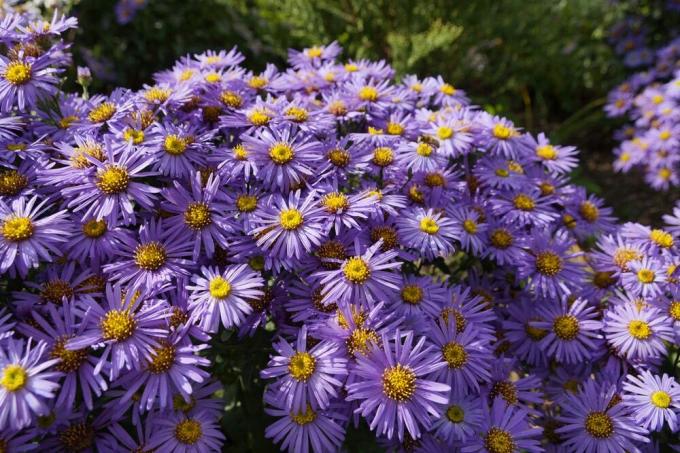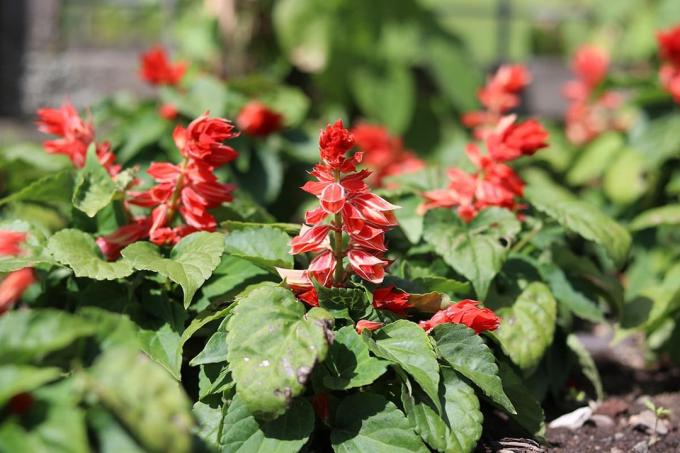

Table of contents
- The alpine aster in our gardens
- A little plant description
- The care and propagation
- Time for the new plantings
- Characteristics
- particularities
- Varieties (selection)
- Alpine aster rejuvenate
Who doesn't know the little indestructible alpine aster? It has many names such as blue chamois, alpine star flower or blue mountain star herb and is certainly traded under these names in other regions. In principle, however, the alpine aster belongs to the genus of asters, even if they appear smaller than the known aster species. This small plant rightly bears the name alpine aster, because its traditional home is the Alps, the Tatras or the Pyrenees. Even in the Balkans and Asia you can find this little beauty. It even grows at an altitude of 3000 meters, where it prefers dry and warm soils. You can even often find them in the community with the edelweiss. What you should definitely know is that in Germany these small plants are protected by the Federal Species Protection Ordinance and are therefore under species protection.
The alpine aster in our gardens
Nevertheless, the garden lover does not have to do without this beautiful addition to his garden, because the alpine aster is also available as a cultivated garden plant. This also has the characteristic features of the real Alpine aster. This plant is best suited to rock gardens, as otherwise it could easily be overlooked with its small growth. In principle, the alpine aster is an undemanding and easy-care plant that loves to be in a sunny spot. Preferably near a larger stone that can still give off heat after the sun has set. The small plant can grow to between 10 and 25 cm and, thanks to its size, fits perfectly into a rock garden landscape. Their bushy and compact habit also tends to form cushions, resulting in small pretty carpets over time. If the alpine aster is socialized with other aster species, you can achieve beautiful contrasts. The asters should be planted in small tuffs, which may still have different shades of color.
A little plant description
It is already known that the plant does not grow very large. But if you want to get the alpine aster in your garden, you can compare it well with the wild form. The only difference is that the wild form always embellishes the mountain meadows with blue flowers, the cultivated species can appear in different colors. The "Albus" variety comes with pure white flowers, while the "Dark Beauty" has strong purple colors and the "Happy End" has pink flowers. But they all have one thing in common, they have a yellow center. The flowering period of the alpine aster begins in May and ends in mid to late September. The alpine aster has medium-green leaves that are narrow and elongated. They may also have a slight hairiness. The pointed leaves are a nice contrast to the colorful wreaths of flowers. In order for the alpine aster to bloom particularly beautifully, the soil must also be suitable for the plant. The alpine aster needs a permeable, calcareous soil that can be sandy or rocky. But it shouldn't be too dry. It goes without saying that you also have to water the alpine aster. It is important to ensure that the soil does not dry out.
The care and propagation

The first thing you always ask yourself is when is the best time to plant the alpine aster? The gardener says the alpine aster can be planted at any time as long as the ground is not yet frozen. During the growing season, you should remove the withered stems, cutting them down to the bottom. A somewhat vigorous pruning should be carried out either in late autumn or in early spring before the plant sprout again. Since the alpine aster forms small cushions over the years and keeps expanding, at some point it becomes necessary to make a division. This division should be carried out every two to four years. The Alpen-Aster always stays "young". This division is also recommended by the nurseries, because it is known that the Alpine aster is between 3 and 4 years old years., Bald spots in the upholstery look unsightly and give the impression that the plant ailing. And who would want to have these unsightly plants in their garden? So you should remember that these maintenance measures are due again and again. What is the best way to proceed and how should a professional division be carried out?
You take a spade and carefully lift the whole eyrie out of the ground. Then this eyrie is pierced in the middle with the spade. So you should make sure that the spade has a sharp spade edge so that the eyrie is pierced with the first blow. If the spade is dull, the roots will only be crushed and will rot. If you have divided the eyrie, then use your hands to break up these clumps into roughly equal pieces that still have enough roots.
Time for the new plantings
The places that are intended for replanting can still be evaluated with new soil and some fertilizer. Pour the soil a little and let the water seep away. A small, divided plant part is inserted into this moist hole in the ground and the earth is pressed firmly. The plant is then watered well. The watering can be a bit plentiful, so the soil can close well around the roots. The new plants can then beautify new spots in the rock garden or take up a spot on a new dry stone wall. The small alpine asters can even be planted in wall joints. So you can equip your rock garden wonderfully. If you want to plant different colored alpine asters, they can also be grown in pots or you plant the little beauties on the edge of borders, where they also have a good effect come. Alpine asters are a very popular source of nectar for bees, bumblebees and butterflies. If you enjoyed your little asters all summer, you should cover them with some winter protection in winter. So they will unfold all their little splendor again next spring.
Characteristics
- Species/Family: Perennial. Belongs to the daisy family (Asteraceae)
- Maintenance effort: Low. Undemanding and easy to care for
- Flowering time: Depending on the variety, May to September with typical flowers in white, pink or violet and usually with a yellow centre
- Foliage: Elongated, narrow, tapered, hairy leaves in mid-green
- Growth: Bushy, compact growth with cushion formation
- Height: 5 to 25cm
- Location: Sunny to semi-shady, with sunny preferred. Likes to sit on rocks that give off heat. Well-drained, sandy, calcareous, not too dry, also stony soil
- Planting time: Anytime as long as the ground is not frozen
- Pruning: Cut back in late autumn or spring before new growth
- Partners: Pretty with other aster species and in tuffs to several plants
- Propagation: Division in early spring or after flowering
- Care: Water when dry, soil should not dry out completely
- Hibernation: Grateful for some winter protection
particularities
- Is native to the European Alps, the mountains of Asia and North America
- Wild form is under protection
- Considered a short-lived perennial, as it dies after approx. 3-4 years should be aged and rejuvenated (see also rejuvenate Alpen-Aster below)
- Especially popular with butterflies, but also bees and bumblebees
- Can also be kept as a container plant
- Fits well in the rock garden and on dry stone walls, even in wall joints
Varieties (selection)
- `Albus: Pure white flowers
- `Dark Beauty: Deep violet flowers with a yellow center
- `Happy ending: Pink blooming
Alpine aster rejuvenate

The entire nest is carefully lifted out of the ground with a spade and then divided in the middle with the spade blade. The spade blade should therefore be sharp. Individual pieces of approximately the same size are removed with your hands and replanted, whereby the new substrate should be worked up with a little fertilizer. For better growth, it is watered extensively so that the roots get the right contact with the ground.
 garden editorial
garden editorial I write about everything that interests me in my garden.
Learn more about perennials

20 hardy plants that bloom all year round
With plants that flower all year round, you can quickly create an attractive garden that does not require much maintenance, as long as the plants are also hardy. In this post, we will introduce you to 20 plants that are suitable for this.

17 flowering hardy plants May to October
Many plants only show their full splendor for a short time. But there are also types and varieties with a particularly long flowering period from May to October, sometimes even longer. We present 17 flowering hardy plants.

Hardy perennials: 22 perennial bloomers
Hardy perennials as permanent bloomers in the flower bed enchant the garden from early summer to autumn with a colorful bloom. They are easy to care for and magically attract butterflies, bees and the like.

10 care tips for the banana tree
If you like it exotic, cultivate a banana tree as a houseplant or in the conservatory. In summer, the banana plants are even allowed outside for a few weeks. The large leaves that the Musa forms on a false trunk are particularly decorative and impressive, and therefore look like a small tree.

Properly care for globe thistle | 10 tips for care
The globe thistle is an eye-catcher in the garden. Their spherical flowers provide a food source for insects. The globe thistle is not difficult to care for and it is suitable for dry locations. With a few tips on care, the plants will develop even better.

Fire sage, Salvia splendens: care from A to Z
Fire sage is known in botanical jargon as Salvia splendens and is a particularly decorative eye-catcher. But what kind of care does the plant need? Our guide to the salvia shows the important points from A to Z.



